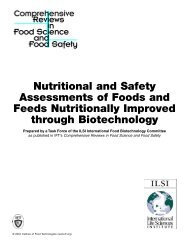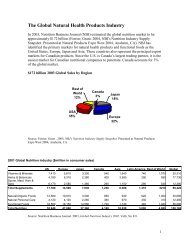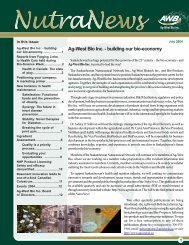Beyond Borders: Global biotechnology report 2010
Beyond Borders: Global biotechnology report 2010
Beyond Borders: Global biotechnology report 2010
Create successful ePaper yourself
Turn your PDF publications into a flip-book with our unique Google optimized e-Paper software.
Of course, this is not a novel development.<br />
Biotech has long been an industry of haves<br />
and have-nots, and many of the trends<br />
we are seeing in the current market — a<br />
challenging IPO environment, investors<br />
looking for de-risked investments — have<br />
been apparent well before the onset of the<br />
financial crisis. While the distribution of<br />
financing certainly became more unequal<br />
in 2009, this in fact only continues a steady<br />
skewing that has been under way for<br />
several years.<br />
Still standing: resilience by any<br />
other name<br />
In the 24 years that we have been<br />
producing annual <strong>report</strong>s on the<br />
<strong>biotechnology</strong> industry, we’ve seen some<br />
recurring themes. Principal among these,<br />
perhaps, is the industry’s remarkable<br />
ability to endure through challenging times.<br />
Indeed, the titles of many of our <strong>report</strong>s —<br />
Endurance, Refocus, Resurgence, Resilience,<br />
to name a few — testify to the creativity and<br />
nimbleness that biotech companies have<br />
shown in crises past.<br />
Despite that storied track record, we<br />
expected this downturn and recovery to be<br />
different. Unlike previous funding droughts,<br />
the current crisis has not been driven<br />
by vacillating investor sentiment toward<br />
biotech stocks, but rather by a fundamental<br />
and systemic recalibration of credit and<br />
capital markets. Anticipating a sustained<br />
reduction in the availability of capital and<br />
“Efficiency has become, in many ways,<br />
the mantra of today’s economic times.<br />
In an era of diminished means, the need<br />
to do more with less ... is being felt by<br />
consumers, corporations and countries.”<br />
a relatively slow recovery, we expected a<br />
sharp reduction in the number of firms<br />
in 2009.<br />
So far, that has largely not happened.<br />
Call it what you will — resilience, flexibility,<br />
durability — this industry has it in spades.<br />
As of December 2008, an extremely<br />
large share of public companies — 37% of<br />
European companies, 44% of US entities<br />
and an incredible 57% of Canadian<br />
firms — had less than a year of cash on<br />
hand. With investors being more selective,<br />
we expected that many of these firms<br />
would not survive the year as independent<br />
going concerns. As it turns out, though,<br />
most of those companies did survive, and<br />
the number of public biotech companies<br />
in established centers shrunk by only 11%,<br />
much less than the 25%–33% reduction<br />
many analysts and industry observers<br />
were expecting.<br />
What happened? To get a better sense of<br />
the story, we went back and looked at the<br />
cohort of US companies that had less than<br />
a year of cash as of December 2008 to see<br />
how they fared during the following year.<br />
As one would expect, some of those firms<br />
— 13% of the total, in fact — were no longer<br />
around a year later, either because they<br />
ceased operations or because they were<br />
acquired. Another 57% of companies were<br />
hanging on but still had less than a year<br />
of cash on hand, and we certainly expect<br />
to see continued attrition in this group in<br />
<strong>2010</strong> — a continuation of the Darwinian<br />
process we described in last year’s <strong>report</strong>.<br />
4 <strong>Beyond</strong> borders <strong>Global</strong> <strong>biotechnology</strong> <strong>report</strong> <strong>2010</strong><br />
The remaining 30% of companies, however,<br />
were able to move up the survival index, and<br />
9% had even moved all the way to the top<br />
cohort, with more than five years of cash<br />
on hand.<br />
Some companies were able to do this by<br />
raising capital despite the challenging<br />
environment. In fact, 21% of capital raised<br />
by US public companies during 2009 went<br />
to firms that had less than one year of cash<br />
as of December 2008, while another 25%<br />
went to firms that had 1–2 years of cash<br />
on hand. Those are impressive totals, but<br />
there was a haves-and-have-nots story<br />
here, too. More than 40% of the money<br />
raised in these two cohorts went to just four<br />
companies, two of which — Human Genome<br />
Sciences and Dendreon — were able to raise<br />
exceptionally large sums on the back of<br />
positive clinical trial news.<br />
Clearly, a key driver of survival for many<br />
companies was their ability to find ways<br />
of operating more efficiently. This is not<br />
entirely surprising, since efficiency has<br />
become, in many ways, the mantra of today’s<br />
economic times. In an era of diminished<br />
means, the need to do more with less (i.e.,<br />
boost efficiency or output per unit of input)<br />
is being felt by consumers, corporations<br />
and countries. The big legislative issues of<br />
the day — from energy policy to health care<br />
reform — are also fundamentally about the<br />
search for more efficient solutions. (Media<br />
coverage of US health care reform has often<br />
focused on expanding access to insurance,<br />
but the legislation is really about expanding<br />
access while containing costs — and to<br />
achieve those somewhat contradictory goals<br />
will inevitably require increasingly efficient<br />
ways of delivering health care.) And by the<br />
same token, the constituents of the biotech<br />
ecosystem are being challenged as never<br />
before to find more efficient ways to deploy<br />
scarce capital, defray the high costs of<br />
R&D and share the risks and rewards of<br />
drug development.








